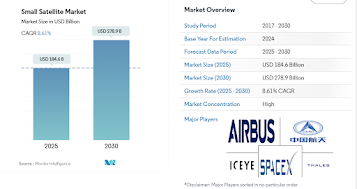From Launch to Market Share: Understanding the Small Satellite Industry Landscape
Introduction:
The
global Small Satellite Market,
valued at USD 184.6 billion in 2025,
is poised for significant expansion, expected to reach USD 278.9 billion by 2030, registering a CAGR of 8.61%, according to market research insights. This growth
is driven by advancements in miniaturization, lower launch costs, and the
increasing demand for satellite-based services across industries.
Why Small Satellites are Reshaping the Space
Industry
Small
satellites, often referred to as smallsats,
typically weigh less than 500 kg and have gained widespread attention due to
their cost-efficiency, rapid development cycles, and versatile applications.
Their market share has grown steadily as they provide affordable access to
space for governments, research institutions, and private companies alike.
With the
growing need for satellite-enabled communication, remote sensing, earth
observation, and scientific research, smallsats have become a crucial component
in both commercial and defense sectors. Constellations of small satellites are
increasingly being used to provide global broadband connectivity, improve
disaster management, and monitor environmental changes.
Explore our full library
of Automotive Research Industry Report :
https://www.mordorintelligence.com/industry-reports/small-satellite-market?utm_source=blogger
Key Market Trends Driving Growth
Several
trends are shaping the small satellite market's trajectory:
- Increased Demand for
Constellations:
Companies like SpaceX, OneWeb, and Amazon's Project Kuiper are deploying
large constellations of small satellites to deliver broadband services
worldwide, contributing to a significant rise in smallsat launches.
- Advancements in
Miniaturization:
Technological progress in materials, electronics, and propulsion systems
has enabled the development of smaller yet highly capable satellites,
reducing costs while improving performance.
- Commercial Space
Participation: The
market is witnessing a surge in private players and startups entering the
space economy, leveraging small satellites for innovative applications
such as earth observation, navigation, and IoT connectivity.
- Lower Launch Costs: The rise of reusable launch
vehicles and dedicated smallsat launch providers, such as Rocket Lab and
Firefly Aerospace, is making access to space more affordable and frequent.
Market Share Insights and Competitive Landscape
North
America currently holds a significant share of the small satellite market,
driven by high investment levels, established space infrastructure, and strong
participation from companies such as SpaceX, Planet Labs, and Lockheed Martin.
However, the Asia-Pacific region is expected to witness the fastest growth
during the forecast period, fueled by increasing satellite programs from
countries like China and India, as well as a growing commercial space
ecosystem.
The
market remains competitive, with key players focusing on technological
innovation, partnerships, and expansion of satellite constellations to capture
greater market share.
Conclusion
The small
satellite Industry is on an upward trajectory, driven by technological
innovation, cost efficiencies, and the growing demand for satellite-based
services. As more countries and companies turn their attention to space,
smallsats will play a vital role in shaping the future of global connectivity,
research, and security.
Industry Related report :
electric
vehicle market trends


.jpg)
Comments
Post a Comment